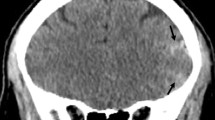Abstract
“Re-build-up” phenomenon, induced by hyperventilation, is a characteristic finding on electroencephalogram (EEG) in children with moyamoya disease, and suggests close correlation with cerebral ischemic attack. Its mechanism, however, remains obscure. In this study, we examined the relationship between the cerebral hemodynamics and this phenomenon before and after vascular reconstructive surgery. Regional cerebral blood flow and its reactivity to acetazolamide were analyzed using the xenon-133 inhalation method and single photon emission computed tomography in six children with moyamoya disease. These results were compared with the EEG. Regional vasoreactivity to acetazolamide was significantly lower in “re-build-up”-positive regions than in “re-build-up”-negative regions. Postoperative studies revealed a significant improvement of reactivity in the regions where the “re-build-up” phenomenon disappeared after surgery. These results suggest that the “re-build-up” phenomenon represents a focal reduction of the cerebral perfusion reserve in moyamoya disease.
Similar content being viewed by others
References
Abe H, Kamiyama H (1987) Surgical treatment of the spontaneous occlusion of the circle of Willis (in Japanese). In: Annual report 1986 of the Research Committee on Spontaneous Occlusion of the Circle of Willis of the Ministry of Health and Welfare, Japan, pp 37–42
Abe H, Kamiyama H, Takikawa S, Kuroda S (1989) Re-build up EEG findings in child moyamoya disease —correlation with Diamox test in 133Xe SPECT (in Japanese). In: Annual report 1988 of the Research Committee on Spontaneous Occlusion of the Circle of Willis of the Ministry of Health and Welfare, Japan, pp 103–110
Gotoh F, Meyer JS, Tomita M (1966) Carbonic anhydrase inhibition and cerebral venous gases and ion in man. Arch Intern Med 117:39–46
Hauge A, Nicolaysen G, Thoresen M (1983) Acute effects of acetazolamide on cerebral blood flow in man. Acta Physiol Scand 117:233–239
Heuser D, Astrup J, Lassen NA, Betz E (1975) Brain carbonic acid acidosis after acetazolamide. Acta Physiol Scand 93:385–390
Isobe M, Kuroda S, Kamiyama H, Abe H, Mitsumori K (1992) Cerebral blood flow reactivity to hyperventilation in children with spontaneous occlusion of the circle of Willis (moyamoya disease) (in Japanese). No Shinkei Geka 20:399–407
Kameyama M, Shirane R, Tsurumi Y, Takahashi A, Fujiwara S, Suzuki J, Ito M, Ido T (1986) Evaluation of cerebral blood flow and metabolism in childhood moyamoya disease: an investigation into “re-build-up” on EEG by positron CT. Child's Nerv Syst 2:130–133
Kanno I, Lassen NA (1979) Two methods for calculating cerebral blood flow from emission tomography of inert gas concentration. J Comput Assist Tomogr 3:71–76
Karasawa J, Kikuchi H, Takahashi N, Utsumi S, Iwayama K, Yamamoto J (1980) Electroencephalographic study of “moyamoya” disease in children —pre- and postsurgical EEG changes and pathophysiology (in Japanese). Rinsho Noha 22:527–536
Karasawa J, Kikuchi H, Nagata I, Naruo Y, Ihara I, Nakagawara J, Miyamoto S, Hashimoto K, Kuriyama Y (1986) Cerebral hemodynamics in moyamoya disease — significance of cerebral blood flow in relation with the changes in arterial CO2 tension (in Japanese). Neurol Med Chir (Tokyo) 26:695–700
Karasawa J, Kickuchi H, Yamagata S, Takeuchi S, Shishido H, Yokshizawa T, Touho H, Miyamoto S, Minamikawa J, Kuriyama Y (1988) Cerebral hemodynamics in moyamoya disease — recovery of cerebral blood flow after hyperventilation (in Japanese). Neurol Med Chir (Tokyo) 28:327–332
Kuroda S, Kamiyama H, Abe H, Houkin K, Isobe M, Mitsumori K (1993) Acetazolamide test in detecting reduced cerebral perfusion reserve and predicting long-term prognosis in patients with internal carotid artery occlusion. Neurosurgery 39:912–919
Kuwabara Y, Ichiya Y, Otsuka M, Tahara T, Gunasekera R, Hasuo K, Masuda K, Matsushima T, Fukui M (1990) Cerebral hemodynamic change in the child and the adult with moyamoya disease. Stroke 21:272–277
Laux BE, Raiche ME (1978) The effect of acetazolamide on cerebral blood flow and oxygen utilization in the rhesus monkey. J Clin Invest 62:585–592
Matsushima T, Inoue T, Suzuki SO, Fujii K, Fukui M, Hasuo K (1992) Surgical treatment of moyamoya disease in pediatric patients — comparison between the results of indirect and direct revascularization. Neurosurgery 31:401–405
Ohyama H, Niizuma H, Fujiwara S, Suzuki J (1985) EEG findings in moyamoya disease in children — concerning the causal genesis of re-build up (in Japanese). No Shinkei Geka 13:727–733
Tagawa T, Naritomi H, Mikami T, Yabuuchi H, Sawada T (1987) Regional cerebral blood flow, clinical manifestations, and age in children with moyamoya disease. Stroke 18:906–910
Takahashi A, Fujiwara S, Suzuki J (1985) Cerebral angiography following hyperventilation in moyamoya disease — in reference to the “re-build-up” phenomenon on EEG (in Japanese). No Shinkei Geka 13:255–264
Takikawa S, Kamiyama H, Abe H, Mitsumori K, Tsuru M (1990) Hemodynamic evaluation of vascular reconstructive surgery for childhood moyamoya disease using single photon emission computed tomography. Neurol Med Chir (Tokyo) 30:389–395
Vorstrup S, Henriksen L, Paulson OB (1984) Effect of acetazolamide on cerebral blood flow and cerebral metabolic rate for oxygen. J Clin Invest 74:1634–1639
Vorstrup S, Brun B, Lassen NA (1986) Evaluation of the cerebral vasodilatory capacity by the acetazolamide test before EC/IC bypass surgery in patients with occlussion of the internal carotid artery. Stroke 17:1291–1298
Vorstrup S, Jensen KE, Thomsen C, Henriksen O, Lassen NA, Paulson OB (1989) Neuronal pH regulation: constant normal intracellular pH is maintained in brain during low extracellular pH induced by acetazolamide — 31P-NMR study. J Cereb Blood Flow Metab 9:417–421
Yamaguchi T, Tashito M, Sugi T, Kitamura K (1980) Nation wide survey of obstruction of circle of Willis (in Japanese). In: Annual report 1979 of the Research Committee on Spontaneous Occlusion of the Circle of Willis of the Ministry of Health and Welfare, Japan, pp 9–16
Author information
Authors and Affiliations
Rights and permissions
About this article
Cite this article
Kuroda, S., Kamiyama, H., Isobe, M. et al. Cerebral hemodynamics and “re-build-up” phenomenon on electroencephalogram in children with moyamoya disease. Child's Nerv Syst 11, 214–219 (1995). https://doi.org/10.1007/BF00277656
Received:
Issue Date:
DOI: https://doi.org/10.1007/BF00277656




